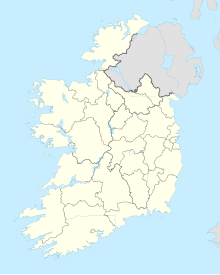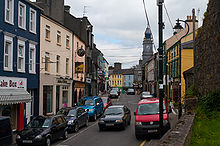Tuam (Ireland)
Tuam ( Irish : Tuaim ) is a country town in County Galway in the Republic of Ireland with 3517 inhabitants (as of 2016); the population of the agglomeration was 8,767 in 2016. The city is west of the Midlands and northeast of Galway City .
Tuam has a reputation for being a pleasant place. There is a saying that says: If a person from Tuam dies and comes to the gate of heaven, the angel will say, "You will not like it here, it is not Tuam".
history
The village was founded by St. Jarlath at the transition from the 5th to the 6th century and has since been the seat of the Archdiocese of Tuam .
St. Mary's Mother and Baby Home
Tuam became known beyond the country's borders through the discovery of a mass grave with children's corpses. As early as 1975, two boys had moved a broken concrete slab over an earlier septic tank and discovered children's skeletons underneath. At that time, however, there was no investigation; the mass grave was only blessed by a priest. According to the population register, an average of two children per week had died in the home from 1925 to 1961. Police investigations only started in 2014 after historian Catherine Corless investigated and published initial results.
On February 3, 2017, a commission of inquiry into mother and child homes based in Dublin gave the results of the mass grave discovered in 2014 with the remains of around 800 children's bodies in the St. Mary's Mother and Baby Home, which was operated from 1925 to 1961 Congregation of the Sisters of Bon Secours known for single mothers and their children. According to investigators, the bone finds examined were fetuses and children between the ages of two and three years in 17 of 20 underground chambers. According to media reports, the home in Tuam was one of ten facilities in Ireland, in which a total of around 35,000 single mothers, so-called “fallen women”, were housed and some of them had to do forced labor .
religion
The city has two cathedrals. The older, 14th century St. Mary's Cathedral , was Anglicanized under Elizabeth I and is the main church in the Diocese of Tuam, Killala and Achonry of the Church of Ireland . It partially burned down in 1767 and has been restored with changes. It contains two of the most famous Celtic crosses in Ireland. One is labeled with a prayer for King Turlough O'Conner.
It was not until 1827–1837 that the long suppressed Catholic diocese was able to build the new Cathedral of the Assumption as the new mother church of the Archdiocese of Tuam .
traffic
Tuam is on the disused western rail link from Limerick to Sligo . There is a campaign to reopen this link to use it as a western north-south link.
After Tuam leads from Galway the forth motorway (motorway) M 17 which merges here into the national road N 17, and the national road N crosses 83rd
Sports
The city has a long tradition of Gaelic football . St. Jarlath College is the record winner in the Hogan Cup (the national championship for secondary schools ). Since 1946 you have been able to enter the list of winners 12 times, the last time in 2002.
Town twinning
- Straubing in Bavaria (Germany) has been the twin town of Tuam since 1991.
Personalities
The members of The Saw Doctors are among the city's celebrities; the city is on the N17 road, as one of the band's songs is called.
The engineer and union activist Mike Cooley (* 1935), who received the Right Livelihood Award in 1981 , was also born here.
Another important figure was Confederate Lieutenant Richard W. "Dick" Dowling. With 47 men and six cannons, he forced an opposing Union force with 2,000 soldiers to turn back in the second battle at the Sabine Pass in the American Civil War .
Web links
- Website of Tuam in County Galway Guide (English)
proof
- ↑ Tuam (Town) on citypopulation.de, accessed on August 10, 2018
- ↑ Tuam (agglomeration) on citypopulation.de, accessed on August 10, 2018
- ↑ Ireland: mass grave discovered with children's bodies , sueddeutsche.de, June 4, 2014
- ↑ Results published after finding a child's corpse. In: Katholisch.de . March 3, 2017, accessed March 4, 2017 .
Coordinates: 53 ° 31 ′ N , 8 ° 51 ′ W




